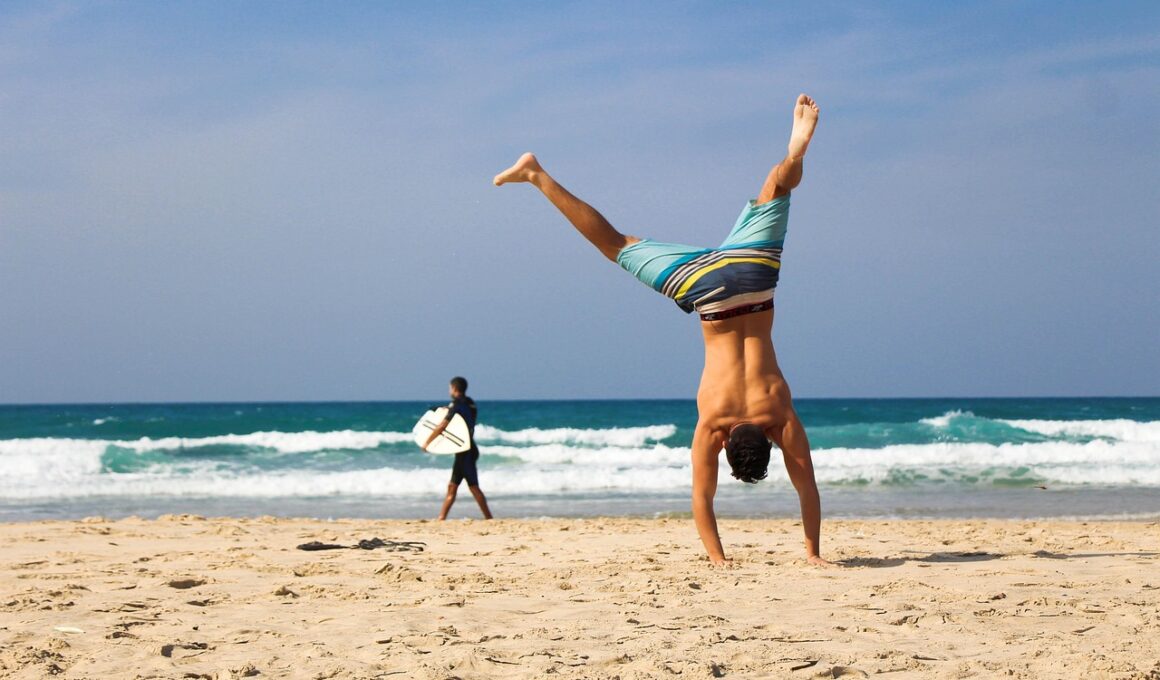Mobility Routine to Improve Handstand Holds and Transitions in CrossFit
Handstands and their transitions are fundamental for many CrossFit athletes aiming for better performance. Improving your handstand holds requires a focus on flexibility, strength, and control, which is why mobility routines are crucial. These routines enhance the range of motion in key muscle groups while also developing stabilization in both static and dynamic positions. Effective mobility routines incorporate various elements such as stretching, foam rolling, and specific drills targeting the wrists, shoulders, and core. To see tangible improvements, athletes should practice these routines consistently, ideally accompanying regular CrossFit training. The goal is to create a full-body connection where every part contributes to the handstand balance. Start by assessing your current mobility levels. Utilize tests like wall handstands or freestanding balances to identify specific weaknesses and areas needing attention. Once you’ve established a baseline, you can drop into a focused routine to work on these areas consistently. With time and dedication, you will notice improved strength and confidence in your handstand holds while transitioning seamlessly between skills during your workouts. Understanding how flexibility contributes to stability will elevate your performance more than you might expect.
Begin with dynamic warm-up movements designed to increase blood flow and prepare your body for handstand work. Include exercises like arm circles, shoulder shrugs, and cat-cow stretches, which should be performed for five to ten minutes. Following this, add mobility-specific exercises to further enhance your readiness for upside-down positions. Incorporate wrist stretches by kneeling on the ground and placing your palms down, fingers facing toward the body, to stretch the forearms. Build strength and mobility in the shoulders by utilizing wall slides. Stand against the wall, ensuring your back and head remain in contact as you raise and lower your arms. This exercise improves shoulder mechanics, which can be a limiting factor in handstands. Transition into your main mobility routine, focusing on specific areas critical for handstands. Allocate time to practice shoulder dislocates with a resistance band, which loosens stiff shoulders and enhances your range significantly. To maximize gains, perform these mobility routines both before and after handstand practice to condition your muscles chronically. Being diligent will build the foundational flexibility and strength needed for successful handstands.
Targeted Stretching Exercises
To directly boost your handstand holds, targeted stretching is essential. Focus on stretching hips, shoulders, and thoracic spine, as these areas highly impact performance. For hips, adopt a pigeon pose, holding for at least 30 seconds on each side. This opens up the hip flexors, allowing for better alignment during the hold. Next, you can try a thoracic extension stretch while seated on the floor, supporting your upper back with a foam roller. This mobility work enhances overhead positions like handstands. Shoulder flexibility can also be improved using a doorway stretch, where you press your arms into the frame, provoking a deeper stretch in the chest and shoulders. Collaborating these stretches with breath control fosters relaxation and mobility. Make a habit of incorporating these stretches as your double check procedures in your warm-up schedule. Gradually, you’ll feel a difference not just in your mobility, but in your confidence for performing handstand transitions and holds under increased load. Your hard work will undoubtedly pay off, leading to unencumbered performances in your workouts. Commitment to these routines will become invaluable as you progress.
In addition to stretching, implementing foam rolling techniques will complement your mobility routine and enhance recovery. Begin with a foam roller on your upper back, rolling from your mid-back to your shoulders. This technique loosens tight muscles around the shoulders, aiding in improved movement quality when inverted. Focus on the lats and triceps as well, pushing the foam roller along the muscle fibers to release tension. Spend about two minutes per muscle group, allowing ample recovery time in between. To address tight hip flexors, also incorporate rolling over the glutes. You can utilize a lacrosse ball here to find and relieve local knots in the glutes and hip region. Poor flexibility in these muscles can significantly hinder your handstand performance, so paying attention pays off. Utilize these rolling techniques consistently before your practices and stronger workouts. By effectively loosening tight muscle groups surrounding the shoulder complex and hip joints, you’ll establish a crucial advantage. Your overall feel and balance during handstands will enhance, enabling easier transitions into other complex maneuvers throughout CrossFit training.
Strengthening Drills for Stability
Incorporate strengthening drills into your mobility routine to bolster your handstand holds. Core strength plays an integral role in maintaining balance, so prioritize exercises such as hollow holds and plated toe touches. These exercises activate the core and promote stability, consequently facilitating control when inverted. Engage in push-up progressions, focusing on consistent form and controlled movements. As strength increases, shift to variations like handstand push-ups against a wall to bring together stamina and mobility work. Building your stabilizer muscles is crucial for proper handstand alignment during transitions. Consider trying a ‘scapular push-up’ to create shoulder awareness and control that will pay dividends when holding a handstand. Attaching resistance bands to your wrists while executing push-ups can further enhance this drill by reinforcing shoulder integrity. Consistency with these movements builds the muscular engagement necessary to positively impact your performance, keeping your body aligned as you hold or transition through the exercises. As you work on strength pieces, you will ignore thoughts of falling and allow your body to become ready and capable.
The combination of mobility work with focused strength exercises contributes to creating an effective routine tailored specifically for handstand development. Ensure that each element of your routine loops together seamlessly. This holistic approach fosters integrity, stability, and, ultimately, successful handstand holds and transitions. Always consider implementing breathing techniques or mindfulness practices as they can aid recovery and mobility. Holding poses while synchronizing breath can deepen your stretches tremendously, creating a mind-body connection crucial for CrossFit athletes. After completing your mobility routine, incorporate some light cardiovascular exercise to promote blood flow and healing throughout the body. Activities such as jogging or cycling for five-to-ten minutes can stimulate circulation, helping with recovery. Recording your progress will inform individuals regarding their areas requiring focus going forward. Adaptations in your routine should be frequent and planned, addressing shortfalls and emphasizing improvements since no single routine works forever. Remain flexible to altering your practices based on your growth, and maintain an open mindset towards learning. Be prepared to witness your desired results once you commit to this mobility routine.
Conclusion: Embracing Mobility for Enhanced Performance
In conclusion, integrating a well-structured mobility routine is indispensable for CrossFit athletes seeking to enhance their handstand holds and transitions. Flexibility, strength, and stability can greatly affect how effectively you perform these skills. By routinely engaging in stretching, foam rolling, and strengthening drills catered specifically toward your handstand goals, you establish a solid foundation. Be patient with your progress and consistent with your efforts as mastery of these skills takes time. Making your mobility routine a daily habit ensures sustained improvement, allowing you to push through plateaus over time. Keep evaluating and fine-tuning your routine to meet your body’s current requirements, maintaining balance with your CrossFit training. Observe your performance and celebrate improvements, be they big or small, as they serve as motivating factors to stay committed. Thus, approaching your mobility journey with an open mind leads towards enhancing your handstand abilities significantly. As you prioritize mobility alongside your functional strength work, you empower your movements during workouts, enhancing overall performance in CrossFit. Your dedication to improving mobility will pay off in all aspects of your training, taking your handstand game to new heights.
Consider documenting your journey, as highlighting your growth will further push your commitment to your goals. Remember, every athlete’s journey in mobility is unique, so listen to your body and adjust as necessary. Surround yourself with a community that supports mobility work in CrossFit and shares knowledge on approaches that help them grow. Continue to share your progress and routines, inspiring peers desiring similar development within their training. By fostering a positive environment, every athlete involved can gain access to various tips and routines that enhance everyone’s performance. Visibility through documentation encourages accountability within your practice as well. Keep aiming high and encourage others along the way. Eventually, you may discover your improvements transitioning to faster, smoother workouts and overall progress in various movements in CrossFit. Ultimately, mobility routines represent the invisible work necessary for your fitness journey, leading toward remarkable gains. You create the potential for outstanding performances as you invest in both your flexibility and strength through consistent practice. Reap the rewards of your dedication as your mobility continues to evolve, proving it to be a crucial factor in your CrossFit journey.


